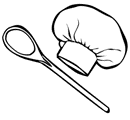Do we really need to brown?
Do we really need to brown meat before braising or stewing?
Many recipes, especially recipes for stews, start by browning the meat in oil before adding the aromatics and the liquids. Why brown the meat? Surely, it will cook even if the browning process is skipped.
I used to believe all that crap about sealing in the juices if the meat is browned before it is braised or stewed — until I realized that there is a difference in the application of the browning and searing process vis a vis the retention of juices when cooking with large or small pieces of meat. For example. Try putting a piece of roast or a whole chicken in an oven that has not been preheated and see how it cooks. Then, compare that with meat or chicken that was place in an oven that has been preheated to the correct temperature. So, when cooking large pieces of food, like a roast or a whole bird, there is some truth to the searing effect and how internal juices are retained in the meat during cooking. The intense heat will immediately sear the outside of the meat or bird and prevent the meat juices from leaking.
But when cooking smaller pieces of meat as when making a stew, and especially when cooking the pieces of meat in liquid, the juice retention argument becomes illogical. The meat will simmer for a long time in the liquid, it will expel juices into the liquid while, at the same time, absorb the liquid in which it cooks. It’s a never ending give and take process. And we know that because, by the time the dish is done, the meat tastes of the ingredients in the sauce while the sauce has acquired a distinct meaty flavor.
So, why brown meat at all? Can we just skip that part altogether? I wouldn’t skip it because browning meat adds texture and better color and flavor to it while adding flavor as well to the sauce in which it cooks.
Let’s illustrate. How do we brown meat?
We heat oil (I mostly prefer a mixture of olive oil and butter) and add the meat. It helps to flour the meat pieces a little to prevent them from sticking to the pan. We brown the meat pieces in small batches to make sure that the temperature of the oil does not drop as high and constant heat is essential to the browning process.
So how does that add texture, color and flavor?
Think in terms of sweetened condensed milk and dulce de leche. Dulce de leche is caramelized sweetened condensed milk but the color, texture and flavor are different from the uncaramelized milk.
Meat is just the same. The browning process caramelizes the natural sugars in the meat creating a richly-colored crust. That crust will help the meat retain its shape during the long simmering hours.
And just how does that lead to a more flavorful sauce? Now, we come to deglazing. The fat in which the meat has browned is so rich in flavor. Cooks saute the aromatics and vegetables in that fat then add a little liquid to scrape whatever browned bits and pieces are stuck at the bottom of that pan. The fat and the browned bits create a wonderful base for a sauce.
But raw meat has very little flavor — where did all the flavors come from? In chemical terms, it is a result of the Maillard reaction — a reaction between the amino acids and sugars in the meat that breaks down large molecules and produces smaller molecules which our senses perceive as flavors and appetite-pleasing aromas.
So, even when using a slow cooker, I still prefer to brown the meat first. It may be an additional step and more work but, in terms of results, the added step of browning meat makes the difference between mediocre and delicious.
